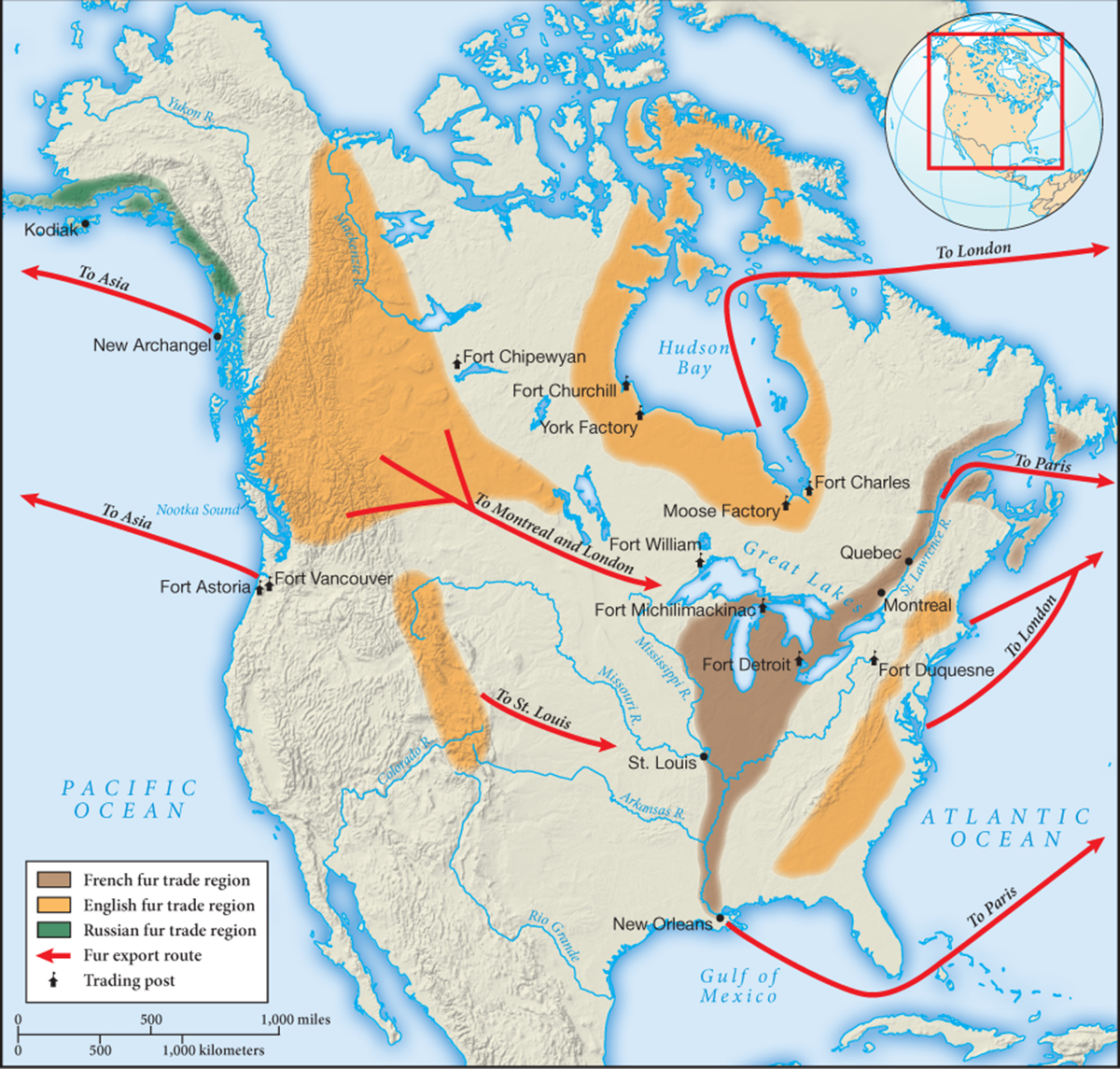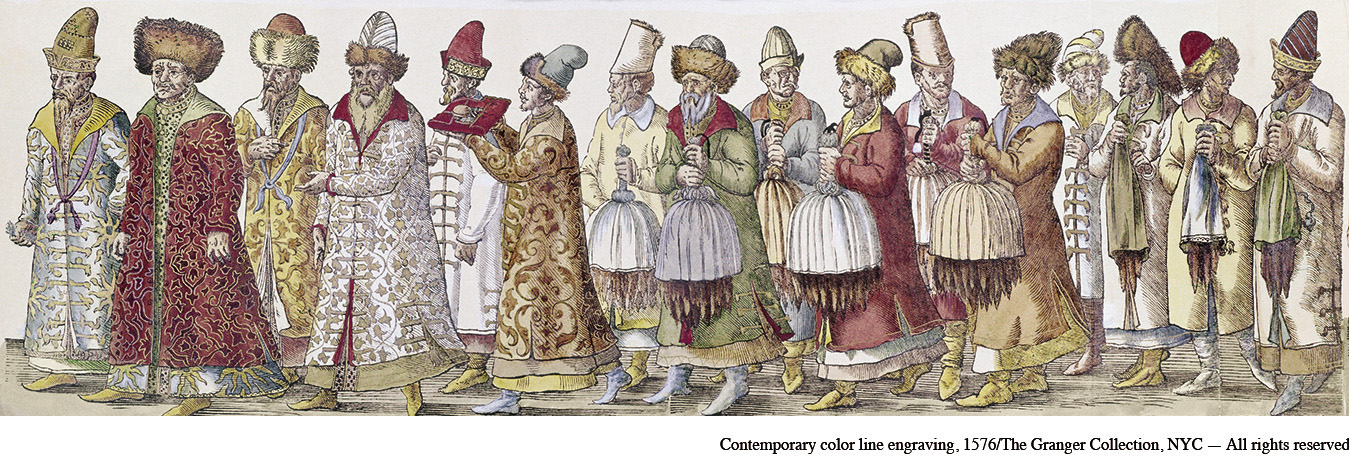“The World Hunt”: Fur in Global Commerce
In the early modern era, furs joined silver, textiles, and spices as major items of global commerce.18 Their production had an important environmental impact as well as serious implications for the human societies that generated and consumed them. Furs, of course, had long provided warmth and conveyed status in colder regions of the world, but the integration of North America and of northern Asia (Siberia) into a larger world economy vastly increased their significance in global trade.
Change
Describe the impact of the fur trade on North American native societies.
By 1500, European population growth and agricultural expansion had sharply diminished the supply of fur-
Like other aspects of imperial expansion, the fur trade was a highly competitive enterprise. The French were most prominent in the St. Lawrence valley, around the Great Lakes, and later along the Mississippi River; British traders pushed into the Hudson Bay region; and the Dutch focused their attention along the Hudson River in what is now New York. They were frequently rivals for the great prize of North American furs. In the southern colonies of British North America, deerskins by the hundreds of thousands found a ready market in England’s leather industry (see Map 14.3).

Only a few Europeans directly engaged in commercial trapping or hunting. They usually waited for Indians to bring the furs or skins initially to their coastal settlements and later to their fortified trading posts in the interior of North America. European merchants paid for the furs with a variety of trade goods, including guns, blankets, metal tools, rum, and brandy, amid much ceremony, haggling over prices, and ritualized gift giving. Native Americans represented a cheap labor force in this international commercial effort, but they were not a directly coerced labor force.
Over the three centuries of the early modern era, enormous quantities of furs and deerskins found their way to Europe, where they considerably enhanced the standard of living in those cold climates. The environmental price was paid in the Americas, and it was high. A consistent demand for beaver hats led to the near extinction of that industrious animal in much of North America by the early nineteenth century and with it the degradation or loss of many wetland habitats. Other fur-
You know our fathers had plenty of deer and skins and our plains were full of game and turkeys, and our coves and rivers were full of fish. But, brothers, since these Englishmen have seized our country, they have cut down the grass with scythes, and the trees with axes. Their cows and horses eat up the grass, and their hogs spoil our bed of clams; and finally we shall all starve to death.20
For the Native American peoples who hunted, trapped, processed, and transported these products, the fur trade bore various benefits, particularly at the beginning. The Hurons, for example, who lived on the northern shores of Lakes Erie and Ontario in the early seventeenth century, annually exchanged some 20,000 to 30,000 pelts, mostly beaver, and in return received copper pots, metal axes, knives, cloth, firearms, and alcohol. Many of these items were of real value, which strengthened the Hurons in their relationships with neighboring peoples. These goods also enhanced the authority of Huron chiefs by providing them with gifts to distribute among their followers. At least initially, competition among Europeans ensured that Native American leaders could negotiate reasonable prices for their goods. Furthermore, their important role in the lucrative fur trade protected them for a time from the kind of extermination, enslavement, or displacement that was the fate of native peoples in Portuguese Brazil.
Nothing, however, protected them against the diseases carried by Europeans. In the 1630s and 1640s, to cite only one example of many, about half of the Hurons perished from influenza, smallpox, and other European-
Beyond the fur trade, many Native American peoples sought actively to take advantage of the new commercial economy now impinging upon them. The Iroquois, for example, began to sell new products such as ginseng root, much in demand in China as a medicine. They also rented land to Europeans, worked for wages in various European enterprises, and started to use currency, when barter was ineffective. But as they became enmeshed in these commercial relationships, Native Americans grew dependent on European trade goods. Among the Algonquians, for example, iron tools and cooking pots replaced those of stone, wood, or bone; gunpowder weapons took the place of bows and arrows; European textiles proved more attractive than traditional beaver and deerskin clothing; and flint and steel were found to be more effective for starting fires than wooden drills. A wide range of traditional crafts were thus lost, while the native peoples did not gain a corresponding ability to manufacture the new items for themselves. Enthusiasm for these imported goods and continued European demands for furs and skins frequently eroded the customary restraint that characterized traditional hunting practices, resulting in the depletion of many species. One European observer wrote of the Creek Indians: “[They] wage eternal war against deer and bear … which is indeed carried to an unreasonable and perhaps criminal excess, since the white people have dazzled their senses with foreign superfluities.”21
Alongside germs and guns, yet another highly destructive European import was alcohol—
All of this had particular implications for women. A substantial number of native women married European traders according to the “custom of the country”—with no sanction from civil or church authorities. Such marriages eased the difficulties of this cross-

Paralleling the North American fur trade was the one simultaneously taking shape within a rapidly expanding Russian Empire, which became a major source of furs for Western Europe, China, and the Ottoman Empire. The profitability of that trade in furs was the chief incentive for Russia’s rapid expansion during the sixteenth and seventeenth centuries across Siberia, where the “soft gold” of fur-
Comparison
How did the North American and Siberian fur trades differ from each other? What did they have in common?
The consequences for native Siberians were similar to those in North America as disease took its toll, as indigenous people became dependent on Russian goods, as the settler frontier encroached on native lands, and as many species of fur-
SUMMING UP SO FAR
What differences can you identify in the operation and impact of the spice, silver, and fur trades?